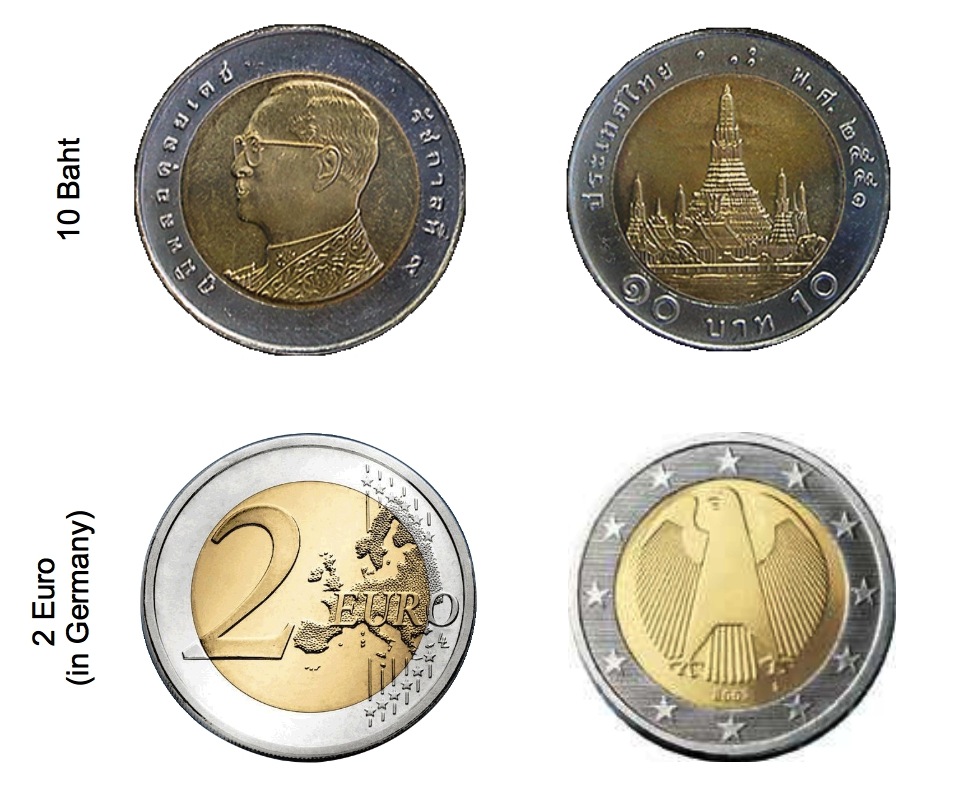The coin looking like a 2 euro... but is not not!
Today, I received from a vending machine a coin that, at a first look, resembles a 2 Euro but definitely is not, and, as you can imagine it is also less worth compared to a 2 Euro (I suspect this was the all point of inserting it into the vending machine!)
Anyway, I made some digging over the World Wide Web and I learned something interesting that's worth to write about.
First of all: the coin looking like a 2 Euro is a 10-baht coin (the Thai currency) and, as you can see, the similarity is pretty strong... (image receiving it as change with other coins!)
(For the comparison 2 Euro vs 10 baht, I used the German 2 Euro, showing the German coat of arms, i.e. the German eagle)
The similarity is deeper that you can suspect ...
Why are these coins so similar?
They look similar because are based on the design of another coin: the Italian 500 Lire!!!
This version of the 500 Lire was introduced in 1981 (and it remained in circulation until 2002 when Euro came out), was the first bimetallic coin of modern times to be produced for circulation, minted using a system patented by Istituto Poligrafico e Zecca dello Stato (translated State Mint and Polygraphic Institute). It was also the first to feature the value in braille (the 10 baht coin also has it).
The Italian 500 Lire, was the first bi-metallic coin of modern times, and I was glad to learn, many of the current bi-metallic coins around the word are based on its (patented) aspect!
Some extra facts: What do the images on these coins represent?
10-baht:
Its obverse features King of Thailand Bhumibol Adulyadej while its reverse is Wat Arun Ratchawararam Ratchawora Mahavihara (... I have a lot of problems in reading it!!!) seen from the Chao Phraya River.
2-Euro coin:
One face represents the Europe map while the other face is personalized by each countries of the Eurozone.
500 Lire:
The obverse represents the Italian Republic and the reverse is the Quirinal Palace in Rome.
References:
Did you like this post? Why don't you subscribe? :)
Anyway, I made some digging over the World Wide Web and I learned something interesting that's worth to write about.
First of all: the coin looking like a 2 Euro is a 10-baht coin (the Thai currency) and, as you can see, the similarity is pretty strong... (image receiving it as change with other coins!)
(For the comparison 2 Euro vs 10 baht, I used the German 2 Euro, showing the German coat of arms, i.e. the German eagle)
The similarity is deeper that you can suspect ...
| Value | 2 euro 10 baht |
|---|---|
| Mass | 8.4 g 8.5g |
| Diameter | 25.75 mm 26 mm |
| Thickness | 2.20 mm 2 mm |
Why are these coins so similar?
They look similar because are based on the design of another coin: the Italian 500 Lire!!!
This version of the 500 Lire was introduced in 1981 (and it remained in circulation until 2002 when Euro came out), was the first bimetallic coin of modern times to be produced for circulation, minted using a system patented by Istituto Poligrafico e Zecca dello Stato (translated State Mint and Polygraphic Institute). It was also the first to feature the value in braille (the 10 baht coin also has it).
The Italian 500 Lire, was the first bi-metallic coin of modern times, and I was glad to learn, many of the current bi-metallic coins around the word are based on its (patented) aspect!
Some extra facts: What do the images on these coins represent?
10-baht:
Its obverse features King of Thailand Bhumibol Adulyadej while its reverse is Wat Arun Ratchawararam Ratchawora Mahavihara (... I have a lot of problems in reading it!!!) seen from the Chao Phraya River.
2-Euro coin:
One face represents the Europe map while the other face is personalized by each countries of the Eurozone.
500 Lire:
The obverse represents the Italian Republic and the reverse is the Quirinal Palace in Rome.
References:
Did you like this post? Why don't you subscribe? :)



Comments
When I showed it to the shop clerk, she was very surprised, and immediately changed the coin with a good one.
I should write a post about the similar coins around the world... ;)